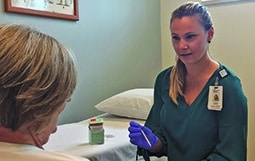When we hear the word “pain,” negative images normally come to mind. Acute pain, while it’s short-lived and results from injury, is the body’s way of telling us something is wrong. The good news is that when the body heals from the injury, acute pain generally stops.
Chronic pain is different because it can last for weeks, months, or even years, and it truly affects our quality of life. Janie Walters had rotator cuff pain that gradually kept getting worse. “I take forever to go to a doctor,” Walters states, “but after about six months, I couldn’t take it anymore.” Because the pain didn’t subside, she knew something was seriously wrong, and she turned to her family doctor, who then sent her to the hospital’s rehabilitation therapy services for help.
Outer Banks Health’s rehabilitation therapy services offers dry needling as a treatment option in addition to their other therapies. Dry needling is a unique type of treatment that inserts a slender, threadlike needle into a muscle, which helps release muscle tension and pain.
The first visit for physical therapy includes a basic manual evaluation performed by the physical therapist, with special tests to determine what muscle tissue is involved and exactly where the pain is located. It is then determined whether dry needling is appropriate.
While this therapy seems similar to acupuncture, according to the American Physical Therapy Association, “The practice of acupuncture by acupuncturists and the performance of dry needling by physical therapists differ in terms of historical, philosophical, indicative, and practical context. The performance of modern dry needling by physical therapists is based on Western neuroanatomy and modern scientific study of the musculoskeletal and nervous systems. Physical therapists who perform dry needling do not use traditional acupuncture theories or acupuncture terminology.”
Physical therapists use dry needling with the goals of relieving pain and/or improving range of motion. According to Lauren Schaefer, Physical Therapist at TOBH, “evidence-based research over the past 10 years has supported the use of dry needling for multiple body regions. I have found it to be extremely effective in reducing tension in muscles that were causing pain and in increasing mobility. The relief for some clients is often instant, with minimal adverse effects. I have yet to experience an intervention as effective as dry needling for treatment of musculoskeletal pain.”
Lee McMaster recently completed dry needling treatment with Schaefer. It was recommended for shoulder and neck muscle tightness and pain as well as arm and hand numbness. McMaster confesses that at first, the dry needling was a little painful, but “there was an immediate and obvious difference in the muscles. The pain and tightness were definitely decreased.”
Walters has had both acupuncture and dry needling. She feels that dry needling is a better method because she noticed a difference right away and the lack of pain has lasted longer. She expresses gratitude for having this type of treatment in our community. “It’s nice to be able to go locally to get treatment for pain that works.” Both Walters and McMaster would “absolutely” recommend this to others.
A physical therapy referral from a doctor is required in order to receive dry needling services. If you think this is a treatment you need, please talk with your primary care physician. He or she can refer you by calling 252-449-4560.


